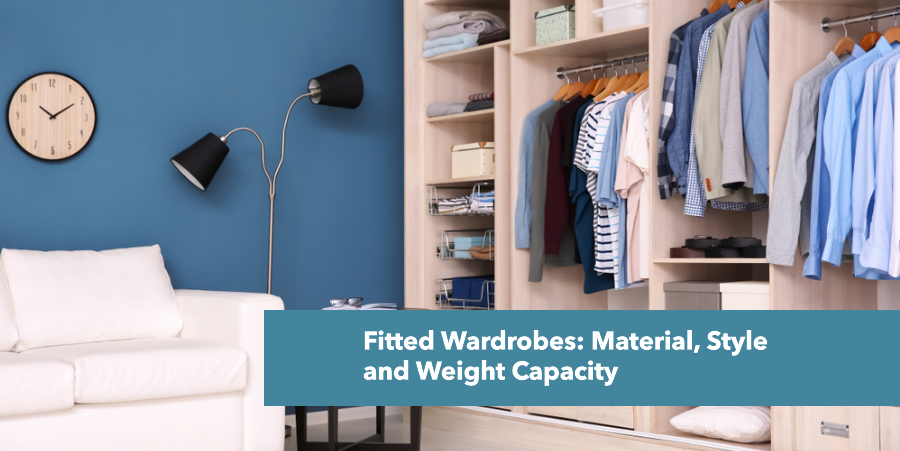What is a Fitted Wardrobe?
A fitted wardrobe is a custom-made storage solution designed to perfectly fit a specific space within a room. Unlike freestanding wardrobes, which can be moved, fitted wardrobes are integrated into the room’s architecture.
What are the Benefits of a Fitted Wardrobe?
Maximum Space Utilization: Designed to fit your specific space, fitted wardrobes make the most of every inch, including awkward corners and alcoves.
Customizable Design: You have complete control over the layout, internal fittings, and exterior finish, ensuring it perfectly matches your needs and style.
Improved Aesthetics: Fitted wardrobes create a sleek and streamlined look, enhancing the overall appearance of your room.
Increased Storage: With floor-to-ceiling and wall-to-wall options, you gain maximum storage capacity for clothes, accessories, and more.
Enhanced Organization: Customizable shelving, drawers, and hanging spaces allow for efficient organization of your belongings.
Increased Property Value: Fitted wardrobes are often seen as a luxury feature, potentially increasing your home’s value.
Are fitted Wardrobes and Built in Wardrobes Same?
Yes, fitted wardrobes and built-in wardrobes are essentially the same thing. Both terms refer to wardrobes that are custom-made to fit a specific space, often a bedroom. They are designed to integrate seamlessly with the room’s architecture, maximizing storage while creating a sleek and streamlined look.
Does Fitted Wardrobe increase Your property Value?
Yes, Fitted Wardrobes Can Increase Your Property Value, Fitted wardrobes are generally seen as a valuable addition to a property. They offer several advantages that appeal to potential buyers.
Materials
What Material is Used for Fitted Wardrobes?
The choice of material for your fitted wardrobe significantly impacts its durability, aesthetics, and cost. Here are the most common materials:
Solid wood: Offers a luxurious look and exceptional durability. Popular choices include oak, cherry, and mahogany.
Plywood: Strong, versatile, and cost-effective. It’s often used as a base for laminates or veneers.
MDF (Medium-Density Fiberboard): Provides a smooth finish and is easy to paint or laminate. It’s a popular choice for modern designs.
Why are fitted wardrobes so expensive?
Fitted wardrobes often come with a higher price tag compared to freestanding options. Here’s why:
Custom design and installation: Each fitted wardrobe is tailored to a specific space, requiring precise measurements, design planning, and skilled installation.
High-quality materials: To ensure durability and longevity, premium materials are often used, contributing to the overall cost.
But dont worry if you are looking for bespoke fitted wardrobe in affordable rates be sure to reach out horizon bespoke joinery for most affordable rates in the market.
Styles and Designs
What are the styles of Fitted Wardrobes ?
The style of your built-in wardrobe can significantly impact the overall look of your room. Here are some popular options.
The style of your fitted wardrobe can significantly impact the overall look of your room. Here are some popular options:
Based on Design Aesthetics:
Modern: Sleek lines, minimalist designs, often with glass or high-gloss finishes.
Traditional: Classic and elegant with intricate details, wood finishes, and ornate hardware.
Contemporary: A blend of modern and traditional elements, focusing on functionality and style.
Shaker: Simple, clean lines with recessed panels for a timeless look.
Art Deco: Geometric patterns, bold colors, and luxurious materials.
Based on Door Style:
Sliding doors: Space-saving and modern, available in various materials and finishes.
Hinged doors: Traditional and offer full access to the wardrobe interior.
Folding doors: Combine features of both sliding and hinged doors.
Mirrored doors: Maximize space and reflect light.
Based on Wardrobe Type:
Walk-in wardrobe: Luxurious and spacious, with ample room to move around.
Corner wardrobe: Efficiently utilizes corner space.
Loft wardrobe: Ideal for maximizing vertical space.
How to Choose a Built in Wardrobe?
Choosing the perfect fitted wardrobe for your Irish home requires careful consideration for Ireland different home settings
Traditional Irish homes: Go for classic styles with wood finishes like oak or pine. Consider incorporating elements like shaker-style doors or ornate hardware.
Modern Irish homes: Sleek lines, minimalist designs, and neutral colors often suit contemporary Irish homes. Glass or high-gloss finishes can add a modern touch.
Sizes and Measurements
How Deep Should a Fitted Wardrobe Be?
The ideal depth for a fitted wardrobe is typically between 55cm and 60cm (approximately 21.7 to 23.6 inches). This depth provides sufficient space for hanging clothes comfortably without creating excessive bulk in the room.
Standard height: 2200mm to 2300mm (approximately 7 feet 2 inches to 7 feet 6 inches)
However, there are some variations to consider:
Shallow wardrobes: For smaller bedrooms or limited space, a depth of 45cm (17.7 inches) can be suitable, but it will restrict the types of clothes you can hang.
Deeper wardrobes: If you have ample space and prefer extra storage, a depth of up to 65cm (25.6 inches) can accommodate longer items like coats and dresses.
How tall should a Fitted Wardrobe be?
Ideally, a fitted wardrobe should extend from the floor to the ceiling. This maximizes storage space and creates a clean, streamlined look.
However, there are practical considerations:
Ceiling height: In older homes with lower ceilings, it might not be feasible to go all the way to the top. In this case, consider building the wardrobe as high as possible without compromising the room’s proportions.
Ventilation: Ensure there’s adequate ventilation at the top of the wardrobe to prevent moisture build-up and mold growth.
Should Fitted wardrobe go to the ceiling?
Yes. A fitted that extends to the ceiling maximizes storage space and creates a clean, streamlined look.
What should be the width of a built in wardrobe?
The width of a fitted wardrobe should be range from 120cm to 180cm (47.2 to 70.9 inches).
Minimum width: For a single-door wardrobe, a minimum of 60cm (23.6 inches) is generally required.
Maximum width: The maximum width is determined by the available wall space in your room.
Finishing
Can you paint over Fitted wardrobes?
Yes, you can paint over fitted wardrobes. It’s a popular way to refresh the look of your room without the expense of replacing them entirely.
Other Considerations
What should a weight bearing capacity of a built-in wardrobe be?
A Fitted wardrobe should be able to support several hundred pounds of weight. However, it’s essential to avoid overloading shelves or hanging rails with excessive weight.
Shelves: Typically support around 20-30 kg (44-66 lbs) per linear meter.
Hanging rails: Can handle around 50-70 kg (110-154 lbs) of clothing weight.
Do Built in wardrobes cause dampness?
No, Generally, fitted wardrobes themselves do not cause dampness. However, they can contribute to damp issues if certain conditions are present:
Poor ventilation
Material Quality
Poor Installation
Do built-in wardrobes need ventilation?
Yes, fitted wardrobes benefit from ventilation. It helps in Prevent moisture buildup, dissipate odors, and protect the wardrobe.
How to Improve ventilation in your Fitted wardrobe?
To improve ventilation in your built-in wardrobe:
Leave small gaps: Ensure there’s a small gap between the top of the wardrobe and the ceiling to allow for airflow.
Install vents: If possible, incorporate small vents into the wardrobe’s design for better circulation.
Use moisture-absorbing products: Place silica gel packs or charcoal bags inside the wardrobe to absorb excess moisture.
Ventilated shelving: Consider using perforated shelves or ventilated storage containers to improve airflow.
Avoid overcrowding: Overfilling the wardrobe can hinder air circulation. Leave some space between items.
Regular airing: Open the wardrobe doors periodically to allow fresh air to circulate.
Installation
Where should I install my Fitted Wardrobe in Bedroom?
The ideal placement for a fitted wardrobe depends on your bedroom’s layout and personal preference. Common options include:
Opposite the bed: Creates a focal point and provides easy access.
Along a long wall: Maximizes storage space and minimizes room clutter.
In a corner: Efficiently utilizes awkward spaces.
Around the bed: Creates a cozy and enclosed feel (ideal for larger bedrooms).
How Long Does It Take to Install a Fitted Wardrobe?
Generally, you can expect the installation to take anywhere from half a day to a full day for a standard-sized wardrobe with a simple design.
How much does it cost to install a Fitted wardrobe in Ireland?
Generally, you can expect to pay anywhere from €800 to €5,000 or more for a fitted wardrobe.

